Best Management Practices for Boxwood Blight: Best management Practices for Virginia Retail Nurseries WITHOUT Boxwood Blight
ID
PPWS-35NP (PPWS-88NP)
1. Avoid introduction
A. Take extra precaution when purchasing plant material.
I. Buy from licensed nurseries and request phytosanitary certificates from vendors or a copy of their Boxwood Blight Cleanliness Program Agreement. A link to the Boxwood Blight Cleanliness Program and other useful links can be found on the Virginia Boxwood Blight Task Force web site (http://www.ext.vt.edu/topics/agriculture/commercial-horticulture/boxwood-blight/).
II. Inspect all newly purchased plant material upon receipt. If a shipment displays boxwood blight symptoms, report immediately to the Virginia Department of Agriculture and Consumer Services by calling: 804-786-3515.
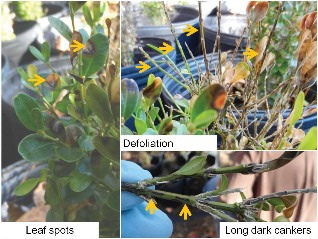
III. Create a holding area for all incoming boxwood and other plant materials.
a. The holding area must be at least 3 meters (approximately 10 feet) from other blocks of plants, but preferably farther. Alternatively, a physical barrier such as an enclosed greenhouse can be used.
b. Locate the holding area on concrete, asphalt, or weed mat to facilitate the cleaning of leaf debris and spilled potting mix.
c. Place all incoming plant material and new cuttings in the holding area for 30 days.
d. Plant material should be inspected regularly for boxwood blight symptoms by trained staff.
e. Clean plant debris by vacuuming, sweeping, or raking on a regular basis.
f. Organize boxwood stock by source and keep stock well labeled so plant origin can be easily identified.
g. Suspend use of all fungicides during the holding period.
h. Consider placing “sentinel plants” that are highly susceptible to boxwood blight, such as English or American boxwood, in your holding zone to detect boxwood blight if you are holding more resistant cultivars.
B. Customer returns and traffic management
I. Do not reintroduce plants to the nursery after they have left nursery property.
C. Shipping and receiving
I. Locate unloading zone on a surface that can be easily swept and cleaned between deliveries.
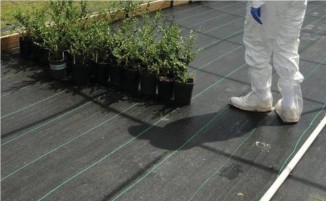
3. Cultural practices
A. Sanitation
I. Minimize host plant debris accumulation by regularly cleaning the ground below plants.
II. Store plants on concrete, asphalt, or weed mat to facilitate the cleaning of leaf debris and spilled potting mix.
III. Host debris should be bagged and incinerated or buried, not added to compost.
IV. Sanitize tools as frequently as practical when working with boxwood. Shears, clip-pers, and other cutting implements should be treated with sanitizer between blocks, groups of plants, etc. Between hoop houses or large display blocks and at the end of the workday, tools such as shears, pruners, shovels, and rakes should be completely rinsed, dried, and a sanitizer applied following label instructions. See appendix 1 for a list of effective sanitizers.
V. Boots should be cleaned and sanitized between hoop houses or large display blocks and at the end of the workday. Alternatively, Tyvek™ boot covers or similar products can be ordered from a commercial vendor and changed between display blocks.
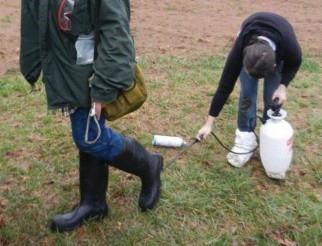
B. Water management
I. Maximize the use of drip irrigation and mini-mize the use of overhead irrigation. When using overhead irrigation, water plants so as to reduce leaf wetness period.
II. Minimize standing water in host plant blocks.
III. Avoid working with plants when they are wet.
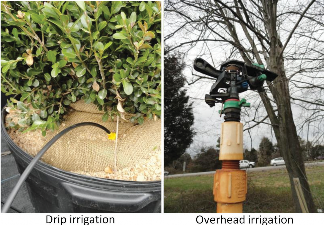
4. Inventory, stocking, storage, and displays
A. Keep stock at a lower inventory and turn over stock more frequently.
B. Consider selling stock that is resistant to boxwood blight. No boxwood are known to be immune to boxwood blight; only partial resistance is available. Contact your local county Extension office for a list of the more resistant cultivars.
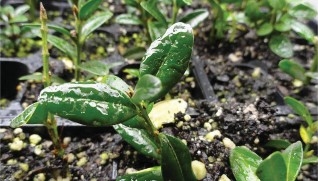
5. Scouting
A. Scout all host plants (Buxus, Pachysandra, and Sarcococca) in the nursery on a weekly basis.
B. Symptomatic plants should be reported immediately to the Virginia Department of Agriculture and Consumer Services. To report symptoms in nurseries call: 804-786-3515.
C. Restrict access to and do not sell symptomatic boxwood until they have been examined and cleared by VDACS.
6. Recordkeeping
A. Maintain records of the following for a minimum of 12 months:
I. Incoming host plants, including quantity and source(s)
II. Location of isolation area(s) for incoming host plants
III. Shipping records (dates, quantity, plants shipped, destinations)
IV. Inspection records
V. Personnel training (dates, attendees, subject matter, trainer)
7. Training
A. Educate and train appropriate personnel to:
I. Understand the potential impacts of further spreading this disease and the importance of strictly following quarantine protocols when handling diseased plants in infested areas.
II. Recognize and report signs and symptoms of boxwood blight.
III. Learn about the disease biology.
B. Develop site-specific sanitation protocols and best management practices in addition to those outlined in this document.
C. Training sessions should be provided at least once each year.
D. Contact your local Cooperative Extension office for information on training opportunities on boxwood blight.
| Active ingredient | Brand name | Rate | Recommended Contact Time for Best Efficacy |
|---|---|---|---|
| Sodium hypochlorite (5.25%) | Clorox, other brands of household bleach | Prepare 1:9 solution. Must be prepared fresh. | 5 min. for tools; 10-15 min. for equipment surfaces |
| Hydrogen dioxide | Oxidate, Zerotol | Prepare 1:100 – 1:300 solution for clean, non-porous surfaces. Prepare 1:50 solution for unclean surfaces. | 5-10 min. |
| Hydrogen peroxide, peroxyacetic acid, and octanic acid | Xeroton 3 (X3) | Prepare 1:500 – 1:1,500 solution for clean, non-porous surfaces. Prepare 1:150 solution for unclean, non-porous surfaces. Prepare 1:300 – 1:1,000 solution for tools. | 10 min. |
| Phenolic compounds (O-benzyl-p-chlorophenol) | Lysol Brand Concentrate Disinfectant | Prepare solution of 1.25 – 2.5 oz/gal. | At least 5 min. |
Note that some disinfectants are corrosive. It is advisable to oil tools after treatment. Also, sanitizers will be most effective if surfaces are free of plant debris and soil prior to treatment.
Virginia Cooperative Extension materials are available for public use, reprint, or citation without further permission, provided the use includes credit to the author and to Virginia Cooperative Extension, Virginia Tech, and Virginia State University.
Virginia Cooperative Extension is a partnership of Virginia Tech, Virginia State University, the U.S. Department of Agriculture, and local governments. Its programs and employment are open to all, regardless of age, color, disability, sex (including pregnancy), gender, gender identity, gender expression, genetic information, ethnicity or national origin, political affiliation, race, religion, sexual orientation, or military status, or any other basis protected by law.
Publication Date
January 6, 2021


